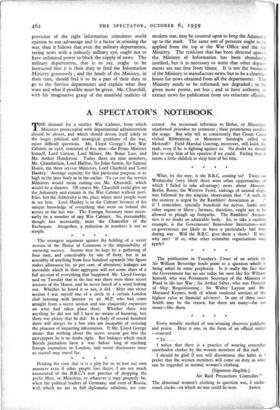A SPECTATOR'S NOTEBOOK
THE demand for a smaller War Cabinet, from which Ministers preoccupied with departmental administration should be absent, and which should devote itself solely to the larger political and strategical problems of the war, raises difficult questions. Mr. Lloyd George's first War Cabinet, in 1916, consisted of five men—the Prime Minister himself, Lord Curzon, Lord Milner, Mr. Bonar Law, and Mr. Arthur Henderson. Today there are nine members, Mr. Chamberlain, Lord Halifax, Sir John Simon, Sir Samuel Hoare, the three service Ministers, Lord Chatfield and Lord Hankey. Average capacity, for this particular purpose, is as high in the later body as in the earlier. To cut out the service Ministers would mean cutting out Mr. Churchill, which would be a disaster. Of course Mr. Churchill could give up the Admiralty and remain in the War Cabinet without port- folio, but the Admiralty is the place where most people want to see him. Lord Hankey is in the Cabinet because of his unique knowledge of everything that went on behind the scenes in the last war. The Foreign Secretary must neces- sarily be a member of any War Cabinet. So, presumably, though less necessarily, must the Chancellor of the Exchequer. Altogether, a reduction in numbers is not so simple.


































 Previous page
Previous page